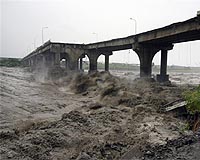| . |  |
. |
Canberra, Australia (SPX) Jun 23, 2009 For the first time scientists have discovered the presence of a natural deep earth pump that is a crucial element in the formation of ore deposits and earthquakes. The process, called creep cavitation, involves fluid being pumped through pores in deformed rock in mid-crustal sheer zones, which are approximately 15 km below the Earth's surface. The fluid transfer through the middle crust also plays a key role in tectonic plate movement and mantle degassing. The discovery was made by examining one millimetre sized cubes of exposed rock in Alice Springs, which was deformed around 320 million years ago during a period of natural mountain formation. The evidence is described in a paper published in the latest edition of Nature entitled Creep cavitation can establish a dynamic granular fluid pump in ductile shear zones. One of the paper's author's CSIRO Exploration and Mining scientist Dr Rob Hough said that this was the first direct observation of fluids moving through the mid-crustal shear zone. "We are seeing the direct evidence for one of the processes that got ore forming fluids moving up from the mantle to the shallow crust to form the ore deposits we mine today, it is also one of the mechanisms that can lead to earthquakes in the middle crust," Dr Hough said. Research leader Dr Florian Fusseis, from the University of Western Australia, said that the discovery could provide valuable information in understanding how earthquakes are formed. "While we understand reasonably well why earthquakes happen in general, due to stress build-up caused by motions of tectonic plates, the triggering of earthquakes is much more complex," Dr Fusseis said. "To understand the 'where' and 'when' of earthquakes, the 'how' needs to be understood first. We know that earthquakes nucleate by failure on a small part of a shear zone." Dr Fusseis said that while their sample did not record an earthquake it gave them an insight into the structures that could be very small and localized precursors of seismic failure planes. The discovery was made possible through the use of high-resolution Synchrotron X-ray tomographic, scanning electron microscope observations at the nanoscale and advanced visualisation using iVEC in Western Australia. The authors of the paper propose that the fluid movement, described as the granular fluid pump, is a self sustaining process where pores open and close allowing fluid and gas to be pumped out. Share This Article With Planet Earth
Related Links CSIRO Bringing Order To A World Of Disasters When the Earth Quakes A world of storm and tempest
 Typhoons Trigger Slow Earthquakes
Typhoons Trigger Slow EarthquakesWashington DC (SPX) Jun 17, 2009 Scientists have made the surprising finding that typhoons trigger slow earthquakes, at least in eastern Taiwan. Slow earthquakes are non-violent fault slippage events that take hours or days instead of a few brutal seconds to minutes to release their potent energy. The researchers discuss their data in a study published the June 11, issue of Nature. "From 2002 to 2007 we monitored deformat ... read more |
|
| The content herein, unless otherwise known to be public domain, are Copyright 1995-2009 - SpaceDaily. AFP and UPI Wire Stories are copyright Agence France-Presse and United Press International. ESA Portal Reports are copyright European Space Agency. All NASA sourced material is public domain. Additional copyrights may apply in whole or part to other bona fide parties. Advertising does not imply endorsement,agreement or approval of any opinions, statements or information provided by SpaceDaily on any Web page published or hosted by SpaceDaily. Privacy Statement |